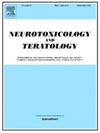拉丁美洲最大露天垃圾场拾捡者对巴西儿童的金属暴露:使用乳牙作为生物标志物
IF 2.8
3区 医学
Q3 NEUROSCIENCES
引用次数: 0
摘要
环境暴露于金属与各种不利的健康后果,特别是儿童的健康后果有关,因此是一个令人关切的公共健康问题。本研究的目的是分析一个露天垃圾场(e结构性区- 1组)拾捡者儿童乳牙中的21种金属(V、Cr、Mn、Co、Ni、Cu、Zn、As、Se、Rb、Ag、Cd、Ba、Ti、Pb、U、Sn、Mo、Ce、La和Th),并与生活在巴西ilia其他两个地区(Ceilandia - 2组和Plano Piloto - 3组)的儿童进行比较。312名儿童参加了这项研究,并对每个儿童的一颗乳牙(牙本质加牙釉质)进行了分析。社会人口变量、母乳喂养时间、看牙医次数、饮水消耗等都是通过向儿童的父母或监护人提供的调查表获得的。金属分析采用电感耦合等离子体质谱法(ICP-MS)。与其他两个地区相比,G1儿童中发现的V、Co、Cu和As浓度明显较高,因为该地区大多数父母都是拾捡垃圾的人(p <;0.01)。G2和G3患儿的铅和镉浓度明显高于G1 (p <;0.01)。G2组儿童的Cr、Mn、Zn和Se水平显著升高(p <;0.01),那里的居民收入也很低,类似于G1。我们发现,与所有三组儿童的犬齿和磨牙相比,门牙中的金属浓度有增加的趋势。本研究提供了新的数据,并加强了乳牙作为儿童金属暴露生物监测的潜在基质的使用。本文章由计算机程序翻译,如有差异,请以英文原文为准。
Metal exposure in Brazilian children of waste pickers from the largest open garbage dump in Latin America: Use of deciduous teeth as biomarker
Environmental exposures to metals is a concern for public health, due to their association with various adverse health outcomes, especially in children. The aim of this study was to analyze 21 metals (V, Cr, Mn, Co, Ni, Cu, Zn, As, Se, Rb, Ag, Cd, Ba, Ti, Pb, U, Sn, Mo, Ce, La, and Th) in deciduous teeth of waste pickers' children from an open garbage dump region (Estrutural region- Group 1), and compare them with children living in two other regions in Brasilia (Ceilandia – Group 2, and Plano Piloto – Group 3). Three hundred and two children participated in the study, and a single deciduous whole tooth (dentine plus enamel) was analyzed from each child. Socio-demographic variables, breastfeeding time, visits to the dentist, drinking water consumption, among others, were obtained through a questionnaire provided to the parents or guardians of the children. Metal analyses were performed by Inductively Coupled Plasma Mass Spectrometry (ICP-MS). Significantly higher concentrations of V, Co, Cu, and As were found in children from G1, where most parents were waste pickers, compared to the other two regions (p < 0.01). Pb and Cd concentrations were significantly higher in children from G2 and G3 compared with G1 (p < 0.01). Significantly higher levels of Cr, Mn, Zn and Se were found in children from G2 (p < 0.01), where residents also have very low income, analogous to G1. We found a trend towards an increase in metal concentrations in incisor compared to canine and molar teeth of children in all three groups. This study provides novel data and reinforces the use of deciduous teeth as potential matrix for biomonitoring children's metal exposures.
求助全文
通过发布文献求助,成功后即可免费获取论文全文。
去求助
来源期刊
CiteScore
5.60
自引率
10.30%
发文量
48
审稿时长
58 days
期刊介绍:
Neurotoxicology and Teratology provides a forum for publishing new information regarding the effects of chemical and physical agents on the developing, adult or aging nervous system. In this context, the fields of neurotoxicology and teratology include studies of agent-induced alterations of nervous system function, with a focus on behavioral outcomes and their underlying physiological and neurochemical mechanisms. The Journal publishes original, peer-reviewed Research Reports of experimental, clinical, and epidemiological studies that address the neurotoxicity and/or functional teratology of pesticides, solvents, heavy metals, nanomaterials, organometals, industrial compounds, mixtures, drugs of abuse, pharmaceuticals, animal and plant toxins, atmospheric reaction products, and physical agents such as radiation and noise. These reports include traditional mammalian neurotoxicology experiments, human studies, studies using non-mammalian animal models, and mechanistic studies in vivo or in vitro. Special Issues, Reviews, Commentaries, Meeting Reports, and Symposium Papers provide timely updates on areas that have reached a critical point of synthesis, on aspects of a scientific field undergoing rapid change, or on areas that present special methodological or interpretive problems. Theoretical Articles address concepts and potential mechanisms underlying actions of agents of interest in the nervous system. The Journal also publishes Brief Communications that concisely describe a new method, technique, apparatus, or experimental result.

 求助内容:
求助内容: 应助结果提醒方式:
应助结果提醒方式:


